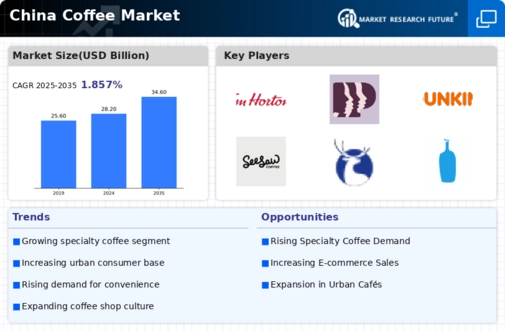Urbanization and Coffee Consumption
The rapid urbanization in China is a pivotal driver for the coffee market. As more individuals migrate to urban areas, the demand for coffee increases, particularly among younger demographics who favor coffee shops and cafes. In 2025, urban areas are projected to account for approximately 60% of the total coffee consumption in the country. This shift towards urban living is accompanied by a growing coffee culture, where convenience and quality are paramount. The coffee market in China is likely to see a surge in specialty coffee shops, catering to the evolving tastes of urban consumers. Furthermore, the increasing number of coffee outlets in metropolitan areas suggests a robust growth trajectory for the coffee market, as urban dwellers seek premium coffee experiences.
Health Consciousness and Coffee Choices
The rising health consciousness among Chinese consumers is significantly influencing the coffee market. As individuals become more aware of health benefits associated with coffee, such as antioxidants and potential metabolic boosts, the demand for healthier coffee options is likely to rise. In 2025, it is estimated that around 30% of coffee drinkers in China will prefer organic or low-calorie coffee products. This trend indicates a shift towards premium and specialty coffee that aligns with health trends. Additionally, the coffee market is expected to see an increase in products that incorporate functional ingredients, such as adaptogens and superfoods, appealing to health-oriented consumers. This evolving consumer preference may reshape product offerings and marketing strategies within the coffee market.
Influence of Western Culture on Coffee Trends
The influence of Western culture is a significant driver of the coffee market in China. As Western lifestyles permeate Chinese society, coffee consumption patterns are evolving. The proliferation of Western-style cafes and coffee chains has introduced new coffee experiences to Chinese consumers. In 2025, it is anticipated that the number of coffee shops in urban areas will increase by approximately 15%, reflecting the growing acceptance of coffee as a daily beverage. This cultural shift is not only changing consumption habits but also encouraging the exploration of diverse coffee flavors and brewing techniques. The coffee market is likely to benefit from this cultural exchange, as consumers seek to replicate the coffee experiences they encounter abroad.
Technological Advancements in Coffee Production
Technological advancements are playing a crucial role in shaping the coffee market in China. Innovations in coffee brewing methods, such as precision brewing and smart coffee machines, are enhancing the consumer experience. Moreover, advancements in agricultural technology are improving coffee cultivation practices, leading to higher quality beans and increased yields. In 2025, it is projected that the adoption of technology in coffee production could enhance efficiency by up to 25%. This not only benefits producers but also ensures a more consistent supply of high-quality coffee to meet the growing demand. As technology continues to evolve, the coffee market is likely to witness a transformation in both production and consumption patterns, fostering a more dynamic market environment.
Rising Disposable Income and Coffee Affordability
The increase in disposable income among Chinese consumers is a key driver for the coffee market. As economic growth continues, more individuals are willing to spend on premium coffee products. In 2025, it is estimated that the average disposable income in urban areas will rise by 10%, enabling consumers to indulge in higher-quality coffee options. This trend suggests a shift towards specialty coffee and artisanal brands, as consumers seek unique flavors and experiences. The coffee market is likely to see a diversification of product offerings, catering to the evolving preferences of a more affluent consumer base. This increase in purchasing power may also lead to greater competition among coffee brands, further stimulating market growth.






















Leave a Comment